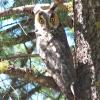It's been over thirty years since I've been to the place in Northern California where I had regular encounters, but that location hasn't changed. No building or other development. I think it is probably still a prime location and plan to return there, assuming I ever get time.
The locations in Lemmon Valley, Nevada may no longer qualify. The valley has seen significant development and is very highly, as opposed to sparsely populated, now. The undeveloped areas moving Northeast along the Western side of Pyramid Lake, through the Pah Rum Mountain Cluster, and on into Southern Idaho are probably still used as a travel route.
The common theme to these areas is that they would qualify as oases within their broader environment. Lemmon Valley was a seasonal travel route (mid-summer) through arid high desert. This means that areas along the route with easy access to water were stop-over points. Where there was water, there was also food in the form of more succulent vegetation for direct consumption and to support prey animals like deer and jack rabbits. There was also an abundance of "snack food" in these areas like lizards, snakes, cicadas, rodents, and small birds. The human communities around these developed water sources also provided gardens, pets, and other food sources. The family group that used to come through would stay for up to six weeks so long as food was plentiful, apparently staying in the hills just above the community.
The spot in Northern California was a high forested plateau bounded by three peaks. Within this high plateau there were about two dozen small lakes, one developed campsite, and two or three hiking or jeep trails. The lakes along the trails were stocked with fish every couple of years and still are. There was a lot of activity there and the family group, again, appeared to hang out one hill away from the campsite and trail with the stocked lakes. We had encounters there from May through September, but those were just the months that we were in the area. The family group may be there year round for all I know. Point is, though, that the high forested plateau provided plenty of water, food, secure areas with multiple easy infiltration and exfiltration routes, hills providing vantage points to observe human activity, and a pleasant summer climate. It was an ideal spot within what is generally considered Squatch habitat.
I think that an experienced operative like yourself, FarArcher, could identify potential oases in areas where there is a history of encounters through simple map reconnaissance. That narrows things down considerably.



